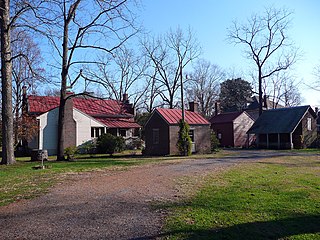
The 88th Illinois Infantry Regiment was an infantry regiment from Illinois that served in the Union Army during the American Civil War. The regiment mustered into service in September 1862 and was engaged at Perryville a month later. The unit subsequently fought at Stones River, in the Tullahoma campaign, at Chickamauga, at Missionary Ridge, in the Atlanta campaign, at Franklin, and at Nashville. The 88th Illinois especially distinguished itself at Stones River, Missionary Ridge, and Franklin. The regiment mustered out of service in June 1865.

The 125th Illinois Volunteer Infantry was an infantry regiment from Illinois that served in the Union Army during the American Civil War. Soon after mustering into Federal service in September 1862, the regiment fought at Perryville. After being stationed at Nashville, Tennessee, the unit briefly fought at Chickamauga and served in the Chattanooga and Knoxville campaigns in 1863. The regiment participated in the Atlanta campaign in 1864, where it took heavy losses at Kennesaw Mountain. It also fought at Peachtree Creek and Jonesborough. At the end of 1864, it served during Sherman's March to the Sea and in 1865 the unit fought in the Carolinas campaign. The regiment participated in the Grand Review of the Armies before being mustered out of service in June 1865.

The 7th Texas Infantry Regiment was a unit of Confederate States Army infantry volunteers organized in 1861 that fought mostly in the Army of Tennessee during the American Civil War. The regiment was captured at Fort Donelson in 1862 and sent to Northern prison camps. After the survivors were exchanged and new recruits added, the regiment was reconstituted and fought at Raymond, Jackson, Chickamauga, Missionary Ridge, and Ringgold Gap in 1863. The unit served in the Atlanta Campaign and at Franklin, Nashville, Averasborough, and Bentonville in 1864–1865. The regiment's 65 survivors surrendered to William Tecumseh Sherman's Federal forces on 26 April 1865.

The 9th Texas Infantry Regiment was a unit of Confederate States Army infantry volunteers organized in December 1861 that fought during the American Civil War. The regiment fought at Shiloh, Perryville, and Stones River in 1862, Chickamauga in 1863, the Atlanta Campaign, Allatoona, and Nashville in 1864, and Spanish Fort and Fort Blakeley in 1865. The remaining 87 officers and men surrendered to Federal forces in May 1865. Two of the regiment's commanding officers were promoted brigadier general.

The 10th Texas Infantry Regiment was a unit of Confederate States Army infantry volunteers organized in October 1861 that fought during the American Civil War. The regiment was captured in its first major action at Arkansas Post in January 1863. After being exchanged three months later, the 10th Texas was consolidated with two other regiments and assigned to Patrick Cleburne's division. Subsequently, the consolidated regiment fought at Chickamauga, Missionary Ridge, and Ringgold Gap in 1863. After becoming an independent regiment again, the 10th Texas fought in the Atlanta Campaign, and at Franklin and Nashville in 1864. After a second consolidation the troops fought at Averasborough and Bentonville in 1865. The regiment's soldiers surrendered to Federal forces on 26 April 1865.
Bernard Laiboldt or Bernard Laibold commanded the 2nd Missouri Volunteer Infantry in the Union Army during the American Civil War. Born in Germany, Laiboldt came to the United States with his family as a child. He joined a Missouri infantry unit during the Mexican–American War. At the start of the Civil War, he became lieutenant colonel of the 2nd Missouri and led the regiment at Pea Ridge. He commanded a brigade at the Siege of Corinth and the Battle of Perryville. He assumed command after the brigade commander was killed at Stones River and led the brigade at Chickamauga. He led the 2nd Missouri at Missionary Ridge, Calhoun, Rocky Face Ridge, and Dalton. He was never promoted to brigadier general and he left the army in December 1864. He was St. Louis Police Commissioner in 1865–66 and later County Marshal.
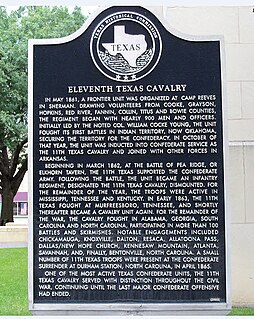
The 11th Texas Cavalry Regiment was a unit of mounted volunteers that fought in the Confederate States Army during the American Civil War. The regiment organized in October 1861 and fought at Chustenahlah against pro-Union Native Americans that winter and at Pea Ridge against Union troops in March 1862. The regiment dismounted to fight at First Corinth, Richmond, and Stones River in 1862. After being remounted, the 11th Texas Cavalry fought at Chickamauga, in Wheeler's October 1863 Raid, in the Atlanta campaign, in Sherman's March to the Sea, and in the Carolinas campaign. When the Confederate army surrendered in April 1865, its remaining soldiers dispersed.

The 10th Texas Cavalry Regiment was a unit of mounted volunteers in the Confederate States Army which fought during the American Civil War. The regiment mustered as cavalry in October 1861 but was dismounted in April 1862 and served as infantry for the rest of the war. The regiment was present at the Siege of Corinth, and fought at Richmond, Ky., Stones River, and Chickamauga in 1862–1863, in the Meridian and Atlanta campaigns and at Nashville in 1864, and at Spanish Fort and Fort Blakeley in 1865. The remaining 65 members of the regiment surrendered to Federal forces on 4 May 1865.

The 14th Texas Cavalry Regiment was a unit of mounted volunteers in the Confederate States Army that fought during the American Civil War. The regiment mustered as cavalry in the fall of 1861 but the soldiers were dismounted in March 1862 and served as infantry for the rest of the war. The regiment fought at the Siege of Corinth, and at Richmond, Ky., Stones River, and Chickamauga in 1862–1863. The unit fought in the Meridian and Atlanta campaigns and at Nashville in 1864, and at Spanish Fort and Fort Blakeley in 1865. The remaining 100 members of the regiment were paroled by Federal forces on 9 May 1865.

The 8th Indiana Cavalry Regiment was an cavalry regiment from Indiana that served in the Union Army during the American Civil War. The regiment mustered into service as the 39th Indiana Infantry Regiment on August 29, 1861, and fought at Shiloh and Stones River. After being converted to mounted infantry, the regiment served in the Tullahoma campaign and at Chickamauga. On October 15, 1863, the unit was renamed the 8th Indiana Cavalry and took part in Rousseau's Opelika Raid, and fought at Brown's Mill and Lovejoy's Station in the Atlanta campaign. The regiment served in Sherman's March to the Sea and the Carolinas campaign before being mustered out of service on July 20, 1865.
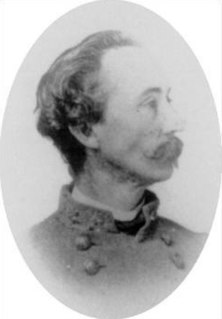
The 12th Louisiana Infantry Regiment was a unit of volunteers recruited in Louisiana that fought in the Confederate States Army during the American Civil War. Formed in August 1861, the regiment served in the Western Theater of the American Civil War and was unique in that there were 12 companies. The regiment garrisoned Island Number Ten before being stationed at Fort Pillow. It fought at Second Corinth in 1862 and Champion Hill and Jackson in 1863. A detachment served during the Siege of Vicksburg and was captured. In 1864, the regiment fought in the Meridian, Atlanta, and Franklin–Nashville campaigns, suffering heavy losses at Peachtree Creek and Franklin. It fought at Bentonville in 1865 before surrendering with General Joseph E. Johnston.
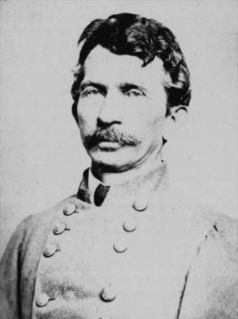
The 4th Louisiana Infantry Regiment was a unit of volunteers recruited in Louisiana that fought in the Confederate States Army during the American Civil War. Formed in May 1861, the regiment served in the Western Theater of the American Civil War. The unit fought at Shiloh and Baton Rouge in 1862 and at Jackson in 1863. A detachment served during the Siege of Port Hudson and was captured. In 1864, the regiment fought in the Atlanta campaign where it lost heavily at Jonesborough. At Nashville in December 1864 most of the men were captured. The survivors were consolidated with several other units and fought at Spanish Fort in April 1865. The remnant surrendered in May 1865.

The 20th Louisiana Infantry Regiment was a unit of volunteers recruited in Louisiana that fought in the Confederate States Army during the American Civil War. The unit began its existence as the 6th Louisiana Battalion in September 1861. The battalion was augmented to regimental strength in January 1862 at New Orleans and served during the war in the Western Theater of the American Civil War. The regiment fought at Shiloh, Farmington, and Perryville in 1862. After being reduced in numbers, the regiment was consolidated with the 13th Louisiana Infantry Regiment and served at Stones River, Jackson, Chickamauga, and Missionary Ridge in 1863. The unit fought at Resaca, New Hope Church, Ezra Church, and Nashville in 1864. The consolidation with the 13th Louisiana was discontinued in February 1865 and the regiment was re-consolidated with other units. It fought its final battle at Spanish Fort one month before surrendering in May 1865.
The 11th Louisiana Infantry Regiment was a unit of foot soldiers from Louisiana that fought in the Confederate States Army during the American Civil War. The regiment fought at Belmont in 1861 and Island Number Ten, Shiloh, and Corinth in 1862. By this time its numbers were seriously reduced, so the regiment was disbanded in August 1862. The survivors mostly transferred to the 13th Louisiana and 20th Louisiana Infantry Regiments, but a few soldiers became part of the 14th Louisiana Sharpshooter Battalion.

The 16th Louisiana Infantry Regiment was a unit of volunteers recruited in Louisiana that fought in the Confederate States Army during the American Civil War. The regiment organized in September 1861 and served during the war in the Western Theater of the American Civil War. The regiment fought at Shiloh, Corinth, and Perryville in 1862. In November 1862, the regiment was consolidated with the 25th Louisiana Infantry Regiment and served at Stones River, Jackson, Chickamauga, and Missionary Ridge in 1863. The unit fought at Resaca, New Hope Church, Atlanta, Ezra Church, Jonesborough, and Nashville in 1864. The consolidation with the 25th Louisiana was discontinued in February 1865 and the regiment was re-consolidated with the 1st Louisiana Regulars and 20th Louisiana Infantry Regiments. The unit fought its final battle at Spanish Fort. The regiment was again consolidated into the Chalmette Regiment shortly before surrendering in May 1865.

The 17th Louisiana Infantry Regiment was a unit of volunteers recruited in Louisiana that fought in the Confederate States Army during the American Civil War. The regiment formed at Camp Moore in September 1861 and served during the war in the Western Theater of the American Civil War. The unit stayed in New Orleans until February 1862 and then moved north. In 1862, the regiment fought at Shiloh and Chickasaw Bayou. In 1863, it fought in the Vicksburg campaign at Port Gibson and in the Siege of Vicksburg, where it was captured. The soldiers were paroled and went home. The regiment reported to a parole camp at Shreveport, Louisiana, in January 1864. The regiment was on garrison duty in western Louisiana for the remainder of the war, before disbanding in May 1865.
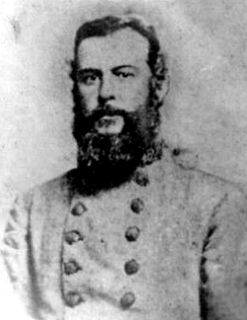
The 18th Louisiana Infantry Regiment was a unit of volunteers recruited in Louisiana that fought in the Confederate States Army during the American Civil War. The regiment began forming in October 1861, but did not reach its full complement of 10 companies until January 1862. It served throughout the war in the Western Theater of the American Civil War. In 1862, the regiment served at Shiloh, First Corinth and Georgia Landing (Labadieville). In 1863, it fought at Fort Bisland and campaigned in south Louisiana. In November 1863, the unit merged with the 10th Louisiana Infantry Battalion, creating the 18th Consolidated Louisiana Infantry Regiment. The new regiment served during the Red River campaign in 1864, fighting at Mansfield, Pleasant Hill, and Yellow Bayou. The regiment remained in Louisiana and Arkansas for the rest of the war, before disbanding in May 1865.
The 25th Louisiana Infantry Regiment was a unit of volunteers recruited in Louisiana that fought in the Confederate States Army during the American Civil War. The regiment organized in March 1862 at New Orleans and served during the war in the Western Theater of the American Civil War. The regiment served at First Corinth and Perryville in 1862. In November 1862, the regiment was consolidated with the 16th Louisiana Infantry Regiment and served at Stones River, Jackson, Chickamauga, and Missionary Ridge in 1863. The 16th-25th Consolidated Louisiana Infantry fought at Mill Creek Gap, Resaca, New Hope Church, Atlanta, Ezra Church, Jonesborough, and Nashville in 1864. The consolidation with the 16th Louisiana was discontinued in February 1865 and the regiment was re-consolidated with the 4th Louisiana Infantry Battalion. The new unit fought its last battle at Spanish Fort. The unit again re-consolidated, becoming two companies of the Pelican Regiment before surrendering in May 1865.

The 30th Louisiana Infantry Regiment was a unit of volunteers recruited in Louisiana that fought in the Confederate States Army during the American Civil War. On 17 December 1861, the Sumter Regiment was accepted into state service at New Orleans. On 1 March 1862, the militia regiment transferred to Confederate service for a 90-day enlistment. At the Capture of New Orleans on 25 April, three and a half companies stayed in the city and were captured. The other companies went to Camp Moore where the regiment reorganized for Confederate service on 15 May 1862, by the addition of four more companies. Company K left on furlough and never returned. The regiment fought at Baton Rouge before being assigned to garrison Port Hudson. On 4 March 1863, two companies were suppressed and their men reassigned to other companies, officially reducing the regiment to a 7-company battalion. However, contemporary records often continued to refer to the unit as a regiment. A detachment was captured at the Siege of Port Hudson, but the bulk of the battalion served at Jackson in 1863, and New Hope Church, Atlanta, Ezra Church, and Nashville in 1864. The survivors were consolidated with the remnants of the 4th and 13th Louisiana Infantry Regiments, and the 14th Louisiana Battalion in February 1864. The men fought at Spanish Fort in March and April 1865, and surrendered in May 1865.

The 24th Louisiana Infantry Regiment was a unit of volunteers recruited in Louisiana that fought in the Confederate States Army during the American Civil War. The Crescent Regiment, a state militia unit, transferred to Confederate service at New Orleans in March 1862 for a 90-day enlistment. The regiment immediately traveled to join the Confederaste army at Corinth, Mississippi, and fought at Shiloh and First Corinth. The regiment disbanded in June at the end of its term of service, most of the men joining the 18th Louisiana Infantry Regiment. The regiment was revived at New Iberia, Louisiana, in September 1862, where it was rejoined by the men in the 18th Louisiana. It fought at Georgia Landing (Labadieville) in October 1862 and at Fort Bisland in April 1863. In November 1863 at Simmesport, the regiment merged with the 11th and 12th Louisiana Infantry Battalions, becoming the Consolidated Crescent Regiment. The new regiment fought at Mansfield, Pleasant Hill, and Yellow Bayou in April and May 1864. At Mansfield, all three field officers were fatalities and 175 soldiers became casualties. The regiment spent the rest of the war in Arkansas and Louisiana before disbanding in May 1865.

















